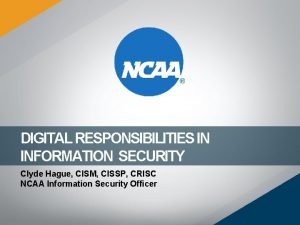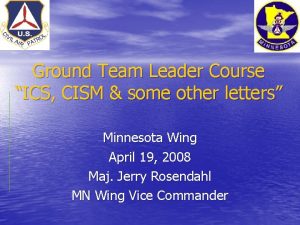The CISM Space Weather Summer School W J

- Slides: 1

The CISM Space Weather Summer School W. J. Hughes and the CISM Team Boston University Introduction The CISM Summer School is an intensive two-week program aimed primarily at students entering graduate school or early in their graduate careers. Professionals in the space weather field, particularly in industry, government or the military, have also benefited from attending. The school provides an overview of the space environment (“Reality”), space weather hazards (“Harsh Reality”), and models that are used to understand, specify, and predict the space environment (“Virtual Reality”). Hands-on use of space weather models is a core component of the school. The goal is to provide students with the Sun-Earth system context for their subsequent more detailed and theoretical study in graduate school, and their thesis research topic. The school is introducing innovative pedagogy at the graduate level and it receives excellent reviews from participants. The Curriculum The summer school curriculum is divided into 4 “courses” that are taught in consecutive segments each day. The morning sessions consist of three lectures focusing on different aspects of the same topic. The afternoon session is devoted to computer lab exercises. Through the two weeks the topics move from the Sun to the upper atmosphere. A Sample two -week schedule of lectures, seminars, and labs is given below. The morning lectures are broken up as follows. SW 101: The Solar-Terrestrial Weather System (Reality) An overview of the solar-terrestrial system that imparts an intuitive appreciation of its parts and their interconnection. The emphasis is on phenomenology and the approach is largely visual with a heavy use of images from spacecraft and computer graphics from numerical models. SW 102: Space Weather Effects and Consequences (Harsh Reality) An introduction to the many ways in which technological society is vulnerable to space weather effects and the indices used to rank the severity of space weather conditions. The approach uses reviews of accounts of historical events and the problems that they have caused. SW 103: Space Weather Models (Virtual Reality) Introduction to the models used to represent and predict conditions in space. The approach is concrete and practical. Representative types of models will be described and students will use the model results in the labs. The Capstone Integrative Project The Faculty The summer school faculty include leaders in the field of space weather drawn from both inside and outside of CISM. Below are listed those scientists/instructors who participated in the Summer School. CISM Team Members Non-CISM Nick Arge, AFRL Robert Brunz, Florida Inst Tech Alan Burns, NCAR Jeffrey Hughes, Boston Univ. Ramon Lopez, Florida Inst Tech John Lyon, Dartmouth College Stan Solomon, NCAR Harlan Spence, Boston Univ. Robert Spiro, Rice University Robert Weigel, George Mason Univ. Michael Wiltberger, NCAR Patricia Doherty, Boston College Michael Golightly, BU Micheal Hesse, NASA/CCMC Keith Groves, AFRL Robert Kerr, NSF Dolores Knipp, Air Force Academy Terry Onsager, NOAA/SEC Peggy Shea, AFRL (Retired) The final day of the summer school is devoted to a capstone project designed to allow the students to use the knowledge they have gained during the two weeks. Students analyze real observational data from several days around a significant space weather event using expert and jigsaw collaborative learning techniques. Expert Groups: First the school is split into four equal-sized expert groups: solar, heliosphere, magnetosphere, and ionosphere/ground-based. Each group is given the data specific to their region and asked to identify important features, properties, chronologies, etc, and to deduce as much as they can about this interval. Equally important is to come up with a series of questions they want to ask of the data being analyzed by the three other groups. Faculty are available to explain what the data plots are, but not what they mean. Jigsaw Groups: New 4 -person groups are created, each containing one person from each of the expert groups -- thus each jigsaw group contains a solar, a heliosphere, a magnetosphere and an ionosphere/ground-based “expert. ” These groups must then piece together what happened in the Sun-Earth system during these period and produce a wall-chart to illustrate their findings. They are asked to explain what happened, identify concepts used, and suggest which models might have been helpful in predicting the outcomes expected during the time period. The students are given the remainder of the morning to complete this part of the project. Wisdom Walk: The Jigsaw Groups’ wall charts are posted during the lunch break. After lunch everyone walks around the posters comparing and learning from what the different groups have determined from the same data sets. Introduction The Sun and Solar Wind Magnetosphere Ionosphere Capstone Monday SW 101 Space Environment (Reality) Tuesday Wednesday Thursday Welcome and Overview The Sun Solar Wind and Coronal Mass Interplanetary Magnetic Ejections (CME) Field Hughes Friday Solar Energetic Particles (SEP’s) Hughes Schwadron SW 102 Effects & Consequences (Harsh Reality) SW 103 Modeling (Virtual Reality) SW 105 Modeling Labs Introduction to Space Weather Effects Solar Radiation Effects I (Flares) Spence The Center for Integrated Space Weather Modeling Hughes Galactic Cosmic Rays (GCR) Space Weather Operations Spence Illg Magnetohydrodynamics and MHD Models The Wang-Sheeley. Arge Model of the IMF and Solar Wind Flow The Community Coordinated Modeling Center Managing Astronaut Radiation Risk Hughes Arge Michael Hesse Golightly Predicting Solar Wind and IMF Conditions at Earth: Wang Sheeley Arge & Bruntz Exploring Solar Wind Structure: Enlil model with DX Predicing the arrival of CMS’s at Earth Introduction to Labs: Exploring solar Visualizing Space magnetic structure Weather Models using MAS Bruntz & Gross Hughes & Arge “Killer Electrons" Deep Dielectric Discharges Owens & Hughes Arge & Bruntz Monday Tuesday Wednesday Thursday Magnetosphere Structure Magnetospheric Storms and Substorms Ionospheric/ Thermosphere Structure Ionospheric Storms Hughes Solomon Burns Predicting Space Weather at the NOAA/Space Environment Center Onsager Ground Induced Currents (GIC) Modeling Equatorial Ionospheric Scintillations Storm Effects on WAAS navigation system Friday Analysis of Real Space Weather Event Onsager Doherty Retterer Magnetospheric MHD Models Radiation Belt Models Magnetic Indices and Empirical Models Aurora Wiltberger Perry Hughes Solomon Visualizing the Magnetosphere (LFM & DX) Numerics and Particle Drift Paths: Programming in Open. DX Satellite Drag Visualizing the Thermosphere & Ionosphere Lyon & Wiltberger Knipp Burns & Solomon Analysis of Real Space Weather Event (continued) Wrap up session and student feedback All Evaluations The response to the summer school has been overwhelmingly positive. On the daily evaluations and the post summer school survey, average participant ratings are all above “ 4” on a 5 point Likert Scale. Participant Comments Pedagogy The Students Various innovative pedagogies are used in the summer school to improve the learning process. The students who attend the summer school are diverse in several respects, gender, employment/school, geographic location, etc. Approximately 30% of those attending are employed by government, industry or the military, and have a job assignment that will benefit from a knowledge of space weather. These, usually young professionals, add a different perspective to the space weather curriculum. Peer Instruction: Programmed into each lecture are “Time out to Think” moments where participants are asked a question that tests the understanding of a concept. Students are asked to give their best answer. There is usually an array of answers given and the instructor calls on a few students to explain the reasoning behind their answer. Then students discuss their ideas with neighbors before answering again. Answers begin to converge on the correct one. Question Cards: At the end of each morning students write a question arising from the morning’s lectures on an index card. These cards are sorted by the instructors during lunch, and are answered at the start of the afternoon session. Modeling Labs: The afternoon modeling labs allow students hands-on use of the model simulations and visualization tools to explore for themselves, for example, the 3 -D configurations of magnetic fields, currents, and plasma in the corona, solar wind, and magnetosphere. Benefits to young space weather professionals include: • Networking with both research and operational leaders in the field • Networking with future researchers • Exposure to the latest research results • Exposure with research models some of which are in transition to operations • Networking with other space weather professionals The following comments made as part of the post summer school survey. • I liked the teachers most and how they presented the material at a good pace. I also liked the data and the way questions were asked after a lecture (pedagogical methods) • SWSS gave me an overall picture of Sun-Earth Interaction. [I liked] the diversity of the SWSS participants. • Complete Sun-> mud overview in a (generally) clear and concise manner without going into excessive detail on any one subject. The CISM Space Weather Summer School for 2006 is listed as an IHY Educational Program

